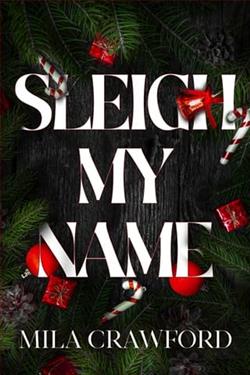Page 130 of Ulune's Daughter
“There are crescent moons on the cup,” Luca says. “Although not on the base.”
Serafina holds up two fingers. “Yes, yes. I will show you why.”
I glance at Luca to see what he’s making of this so far.
His eyes meet mine, almost shyly, but there’s no hiding the excited gleam. He’s controlling his expression, his mouth pressed into a crooked line, but I can feel his bubbling enthusiasm. I smile at him and a grin breaks free.
At the top of the walkway, the fortress begins with a towering rectangle of stone, carved with a coat of arms. Serafina leads us through the gate and along a smaller walkway, skirting the stone wall as it rises above us. Instead of taking a staircase up into the castle itself, she continues to skirt the edge of the wall, until the worked, composite stone gives way to older, unworked rock. The face of one boulder, worn almost smooth with the passage of time and bodies along this walkway, protrudes into the path. When Serafina reaches the worn boulder, she stops and puts her hands flat on the stone.
She glances at Luca and me and tips her head at the rock. We follow her example, placing our hands flat on the rock.
“Amma¯, ja¯nuwa¯ colbhos amma¯.”
The boulder disappears, revealing a long, worked stone tunnel under the fortress.
Serafina starts down the tunnel and I follow her. The tunnel is comfortable for me but is probably making Luca a little nervous because it’s only a hair higher than six feet. My vision fades to the blues and grays of my faesight as we move deeper underground.
The tunnel widens into an egg-shaped chamber. There’s a narrow chimney at the top, letting in a breath of fresh air and a sliver of fading light. There’s no smell, but there’s the subtle weight of death. Serafina called this a womb, but wombs can also be tombs, and this feels like the latter.
The walls of the chamber are riddled with small alcoves. Some hold one urn; some hold several. The urns are clay, metal, marble. Some are plain; others decorated with symbols, inscriptions, even portraits. When I draw close to an alcove that has over a dozen clay urns, each with a meticulously painted portrait, my heart hitches.
All of them are babies.
“Come, come,” Serafina calls softly.
Luca’s standing beside me as I look at the tragic collection of urns. He puts a light hand on my shoulder and draws me toward the center of the chamber. Serafina has climbed up on what looks like a broken clay sarcophagus. It’s ringed with two levels of urns. I carefully clear away the urns from the steps so Luca and I can stand on the top step and see what Serafina’s pointing out.
The sarcophagus is cracked roughly down the middle, with one side caved in and gone to rubble. If there was a body inside the sarcophagus, it’s long gone, although where the head and heart would have been, there are piles of rotting cloth, gray at the bottom and faded red at the top. Layers of tiny cloth rosettes: offerings to the Mother.
Serafina takes a small headlamp out of her bag, slips it over her head, and turns it on so the sarcophagus top is brightly illuminated. Where a funerary mask would ordinarily be at the head, there’s a circle of braided vines. Down the flat breast, there are lines of inscription, the runes packed together with only occasional dots as separators. A nightmare to translate. The inscriptions are separated by symbols in deep relief, pressed so deep into the clay that they look carved in stone. There are hundreds of different symbols, but each line of symbols is bracketed by crescents. As I follow the lines across the baked clay, the crescents start upright near the head, then turn on their sides near the middle of the torso, forming lines of horns. Toward the girdle, the crescents invert so the points are down toward the sarcophagus’ feet.
“Above and below,” Luca murmurs, indicating where the crescents point upwards.
“Yes, yes,” Serafina agrees. “This is the heavens. This is the earth. This is below. And here, here it is.”
She frames a set of runes with her fingers.
“Pethr,” Luca says. He has his phone out, taking pictures of the inscriptions from every angle. “But this might begénhmnay, children or maybe daughters. And look, this could behekeh, water. So instead of the sea’s fearsome horns, this is the water’s or maybe the ocean’s fearsome daughters.”
“Scylla and Charybdis,” I say, drawing the obvious conclusion.
Luca nods. He points out the spiral symbols in the line above the inscription. “Spirals could mean many things, but in this context, surely the whirlpool of Charybdis.”
“And this.” Serafina points to a six-headed arrow symbol below the inscription. “Scylla of the six heads.”
“This is amazing, Serafina,” I say. “Thank you.”
She lifts her head, dazzling me with her headlight. She quickly reaches up and covers it. “Scuzzi. I had not remembered the context. Only the unusual word. I am pleased there is so much more than I remembered.” She dips her head again and takes her phone out of a pocket in her long skirt. She taps and pulls up a picture of the cup’s base, the inscription just visible at the bottom of the picture. “Here, this line of crescents, pointing downward. We are no longer above.” She holds out her free hand, palm down. “We are below the sky and earth. Underground. Perhaps in the underworld. That is where the sea’s fearsome horns now reside.”
Luca grunts but I can’t tell if it’s a grunt of agreement or disagreement.
“Have you dated the sarcophagus?” I ask.
She nods. “Sixteenth century. But it is a replica of a sarcophagus that has been here since before the time of Dionysius, tyrant of Syracuse.”
I know Luca will have made note of the name so we can create a timeline.
We linger for another hour, taking pictures, debating possible translations. Professor Dybo explains that the sarcophagus has not been translated by modern scholars because the castle was under human state control from 1808. The fascists executed magi trying to approach the castle during Mussolini’s control of the country. The castle was recently renovated and made a tourist attraction, at which point it became accessible again. Professor Dybo herself has never entered the rock before and was following instructions in an eighteenth-century Arcana that she gives to Luca before we part ways.















